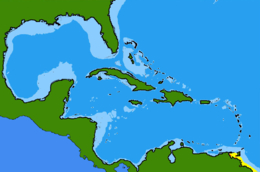
A flatfish is a member of the ray-finned demersal fish order Pleuronectiformes, also called the Heterosomata, sometimes classified as a suborder of Perciformes. In many species, both eyes lie on one side of the head, one or the other migrating through or around the head during development. Some species face their left sides upward, some face their right sides upward, and others face either side upward.

Gars are an ancient group of ray-finned fish in the family Lepisosteidae. They comprise seven living species of fish in two genera that inhabit fresh, brackish, and occasionally marine waters of eastern North America, Central America and Cuba in the Caribbean, though extinct members of the family were more widespread. They are the only surviving members of the Ginglymodi, a clade of fish which first appeared during the Triassic, over 240 million years ago, and are one of only two surviving groups of holosteian fish, alongside the bowfins, which have a similar distribution.

The American soles are a family (Achiridae) of flatfish occurring in both freshwater and marine environments of the Americas. The family includes about 35 species in seven genera. These are closely related to the soles (Soleidae), and have been classified as a subfamily of it, but achirids have a number of distinct characteristics.

The sailfin molly is a livebearer fish typically found in both freshwater and brackish waterways along the East Coast of the United States, from North Carolina south to Florida, and around the Gulf of Mexico to Texas, and south to the Yucatán Peninsula of México. Given their preference for more brackish water conditions, mollies are often found within just a few yards or miles of the ocean, inhabiting coastal estuaries, lagoons, river deltas and swamps, as well as tidal areas with a regular inflow of oceanic minerals and nutrients mixing with inland freshwater sources.
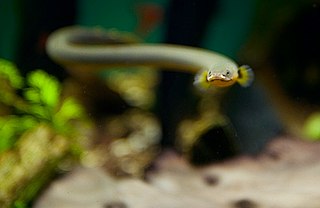
The reedfish, ropefish, or snakefish, Erpetoichthys calabaricus, is a species of fish in the family Polypteridae alongside the bichirs. It is the only member of the genus Erpetoichthys. It is native to fresh and brackish waters in West and Central Africa. The reedfish possesses a pair of lungs in addition to gills, allowing it to survive in very oxygen-poor water. It is threatened by habitat loss through palm oil plantations, other agriculture, deforestation, and urban development.
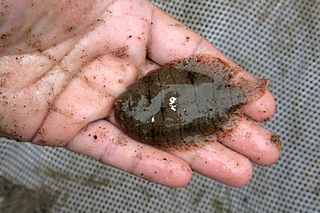
The hogchoker is a small species of flatfish found along the Atlantic and Gulf coasts of North and South America, ranging from Massachusetts to Venezuela. They prefer brackish water, and are abundant in many bays and estuaries north of the Carolinas. It is a member of the American sole family Achiridae. They are usually brown to dark brown in color, and lighter on their "blind side". The overall body color is often broken by a series of spots and thin stripes, which can be lighter or darker than the main body color. The fins and tail have fringed edges helping hide the fish from its prey. They mainly feed on small aquatic insects and invertebrates. They get their common name because East Coast fishermen would feed these so-called "trash" fish to their hogs, after which the fish would bow its body into a suction cup and stick to the soft palate of the hog, rather like peanut butter in a dog’s mouth.
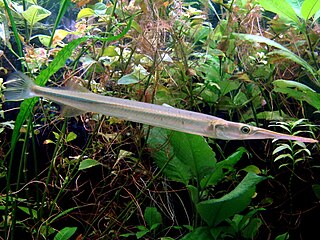
Xenentodon cancila, the freshwater garfish, is a species of needlefish found in freshwater and brackish habitats in South and Southeast Asia.

The Ariidae or ariid catfish are a family of catfish that mainly live in marine waters with many freshwater and brackish water species. They are found worldwide in tropical to warm temperate zones. The family includes about 143 species.

The banded butterflyfish is a species of marine ray-finned fish, a butterflyfish found in the tropical western Atlantic Ocean from Brazil to Bermuda. Common names include the banded butterflyfish, the butterbun, the butterflyfish, the Portuguese butterfly, the school mistress and the banded mariposa.

The Atlantic stingray is a species of stingray in the family Dasyatidae, common along the Atlantic coast of North America from Chesapeake Bay to Mexico, including brackish and freshwater habitats. It may be distinguished from other stingrays in the area by its relatively elongated snout. This species is of little commercial importance, other than for sale in the aquarium industry.
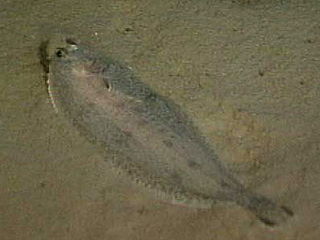
The witch, known in English by a variety of other common names including the witch flounder, pole flounder, craig fluke, Torbay sole, and grey sole, is a species of flatfish from the family Pleuronectidae. It occurs on both sides of the North Atlantic Ocean on muddy sea beds in quite deep water. In northern Europe it has some importance in fisheries as a food fish.

The European flounder is a flatfish of European coastal waters from the White Sea in the north to the Mediterranean and the Black Sea in the south. It has been introduced into the United States and Canada accidentally through transport in ballast water. It is caught and used for human consumption.

The lined sole is a ray-finned flatfish found in the Western Atlantic. Its common length is 17 cm. Often considered a trash fish in commercial trawling, it is of little or no economic value.

The lookdown is a species of game fish in the family Carangidae. It was first described in 1758 by Carl Linnaeus, in the 10th edition of Systema Naturae.

The violet goby is a species of goby native to marine, fresh and brackish waters near the Atlantic coast of North and South America from South Carolina in the United States of America, to northern Brazil. It prefers bays, estuaries and river mouths with muddy substrates. It is often marketed as the dragon goby or dragon fish.

Coastal fish, also called inshore fish or neritic fish, inhabit the sea between the shoreline and the edge of the continental shelf. Since the continental shelf is usually less than 200 metres (660 ft) deep, it follows that pelagic coastal fish are generally epipelagic fish, inhabiting the sunlit epipelagic zone. Coastal fish can be contrasted with oceanic fish or offshore fish, which inhabit the deep seas beyond the continental shelves.

Toxotes chatareus, sometimes known by the common names common archerfish, seven-spot archerfish or largescale archerfish, is a species of perciform fish in the archerfish genus Toxotes.

Achirus is a genus of American soles native to tropical and subtropical parts of the Americas. They are mainly found in coastal areas, including salt and brackish water, but some species are found in fresh water.
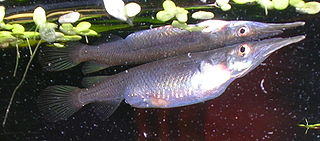
Zenarchopteridae, the viviparous halfbeaks, is a family in the order Beloniformes. The Zenarchopteridae exhibit strong sexual dimorphism, practicing internal fertilisation, and in some cases ovoviviparous or viviparous. The members in the family are mainly found in fresh and brackish water of tropical Asia and New Guinea, but the genus Zenarchopterus also includes marine species from the Indo-Pacific. Several, such as the wrestling halfbeak, have become commonly traded aquarium fish.

Poeciliopsis prolifica, or the blackstripe livebearer, is a species of small freshwater fish in the family Poeciliidae. It is endemic to Mexico. It is a viviparous species and the female can have several clutches of young developing internally at the same time, hence the specific name prolifica, from the Latin proles, "offspring" and ferax, "rich, fruitful" in reference to the great number of young produced.

